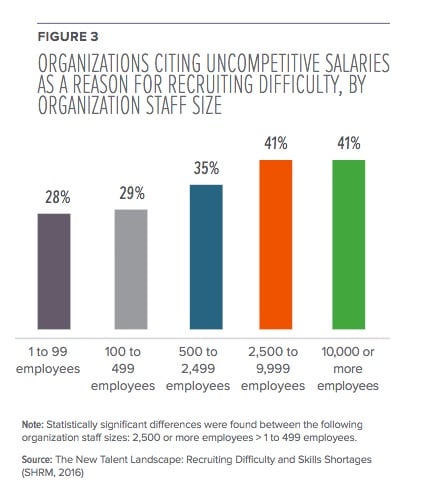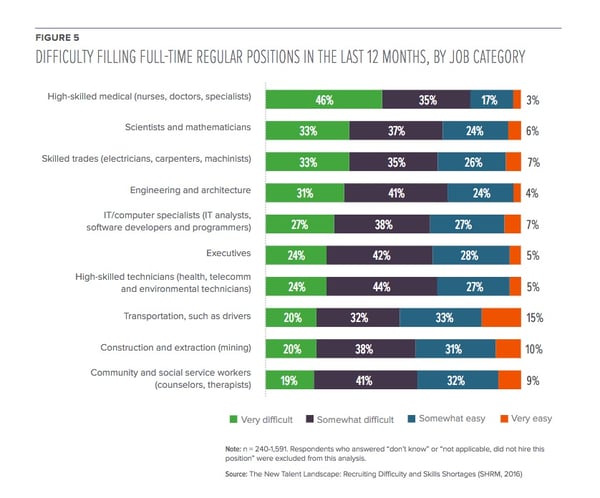With 285,000 members from over 165 countries the Society for Human Resource Management is an incredible resource for up-to-the-minute insights within the recruitment sector. This year, they put our a report called The New Talent Landscape – Recruiting Difficulty and Skills Shortages that examines the overall state of the union of recruitment along with suggestions for recruitment and training strategies. Here are some of the most important insights as well as some best recruiting practices HR professionals can use to remain competitive in the current market.
This Year Will Be Challenging
According to the Society for Human Resource Management (SHRM), “HR professionals across industries are reporting a more challenging market for talent in 2016 compared with 2013.” In addition, SHRM reported that the health and social assistance as well as manufacturing are some of the most difficult recruitment areas at the moment. According to SHRM, HR professionals believe that this recruitment difficulty is due to five major factors (along with several minor ones):
- A small candidate pool to choose from (low application rates) – 51%
- A low level of experience from those who do apply – 50%
- An increased level of competition for talent – 49%
- A small number of candidates with the correct specialized skills to do the jobs – 38%
- A limited amount of local, qualified applicants – 38%
According to SHRM, “68% of HR Professionals are experiencing difficulty recruiting candidates for full-time positions in their organizations.” With the percentage of recruiters reporting difficulties in talent acquisition and a lack of qualified or event interested candidates, it is more important than ever that recruiters avail themselves of best recruiting practices hewn they begin new searches or conduct ongoing campaigns.
1. Build in a Training Budget
As SHRM noted, many candidates who submit applications aren’t fully qualified for the position they want to perform. This issue has resulted in major skill shortages within companies and the solution to combatting the problem is simple: a training budget. According to SHRM, “despite high levels of recruiting difficulty and many areas of skills shortages, nearly one third of HR professionals report that they are working without a training budget.”
If your company is part of that one third, consider talking to your recruitment manager about instituting one. Recruitment training budgets allow for existing employees to attend events like conferences and also fund on-the-job training. In addition, that same budget can be used to put an apprenticeship program in place, which would provide recruiters with an in-house talent pipeline of candidates who are uniquely qualified for the positions they need to fill.
2. Hold on to Existing Talent While Training New Blood
As baby boomers move toward retirement, shortages will inevitably increase. If you can hold on to that generation longer, you can be ahead of the game. According to SHRM, “Organizations that can continue to engage their mature workforce and even retain them beyond retirement age will have an advantage.” This advantage will help you lower your recruitment costs as there will be no vacant slots and will allow you to make sure your new talent is trained in the best possible manner by workers with seniority.
We suggest researching what your baby boomer employees value and doing whatever it takes to keep them. For instance, if you have doctors who are moving toward the retirement age, make sure to make them aware that locum tenens is an option if they would like to continue with your company past their expected retirement age.
3. Review Your Salaries and Benefits
When it comes to recruiting for full-time regular positions, anywhere from 28-41% of HR professionals depending on the company size report that uncompetitive salaries are a factor.
If you are having trouble recruiting for full-time positions, consider checking to see if your salaries are industry competitive. While salary isn’t everything it certainly seems to be a sticking point for many recruiters.
4. Understand Your Industry Trends
Unfortunately, if you are in the healthcare sector, you are in for a tough year.46% of those recruiters who are seeking highly skilled medical professionals are having sourcing issues. The first step to becoming a stronger competitor is simply to understand your industry, track trends and make appropriate changes within your company. Oftentimes, observing companies who are achieving high levels of success is the best route to finding a more effective model.
We recommend that you read the full SHRM report here as it features a more in-depth look into specific positions and trends that you may want to be aware of before starting your next round of recruitment marketing.
--
Did you enjoy this article? Would you like to read others like it? Consider subscribing to our blogs.














